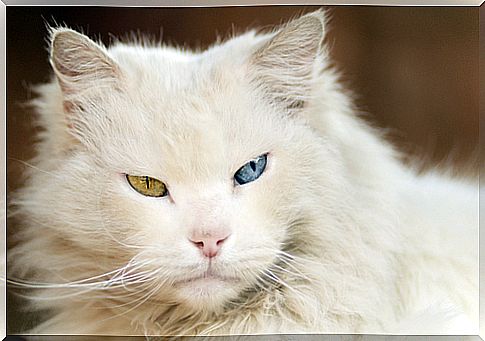Amazing Curiosities About Deafness In Albino Cats

There are many things we do not know about our feline friends, some are funny, some fascinating and some just curious. For example, things appear in them that do not seem to have any relationship, such is the case of deafness in albino cats. However, it is not a magical or incomprehensible situation, so we invite you to continue reading to see some curiosities about this strange condition.
features
Before talking about the curiosities related to deafness in albino cats, it is necessary to make a precision and that is to identify when a cat is, in fact, albino.
A very common mistake is to believe that all white cats are albinos, because although there are many similarities, they are differentiated by a condition that is genetic. Albinism is a mutation characterized by the absence of melanin (which allows pigmentation in the eyes, fur and skin). Therefore, the coat of an albino cat will be completely white with pink fur without spots or moles. The eyes of albino cats vary between blue and those with heterochromia, below we will see why.
Presence of the W gene
What generates white fur, blue eyes and deafness is a gene called the W gene (White, for white in English), and this conditions these characteristics in the cat that is not related to the other genetic information it has, this means that it is a predominant gene.
However, this is almost like a genetic lottery. Well, not all white cats are albinos, although all white cats have the presence of the W gene, from which they receive their color; Likewise, not all albino cats are deaf (although most are), and many white cats are deaf (due to the presence of the gene that gives them the color that also contains the genetic information of deafness).
Eye color and deafness

One relationship that exists between white cats and deafness is that it appears to be more severe and more frequent in blue-eyed cats. This is due to the “purity” (we use the word purity just to give a general idea) of the W gene. Furthermore, blue-eyed white cats (regardless of whether they are albinos) are almost 20% more likely to be deaf than a white cat with another color variation in its eyes.
Cats with one blue eye and one green or yellow eye (heterochromia) will be less likely to be deaf or suffer from partial deafness, also deafness will develop in the ear in which the cat has a blue eye.
White cats with eyes a color other than blue or without heterochromia, for example those with yellow or orange eyes, are not usually deaf. Currently, attempts are being made to eliminate deafness in white cats through selective breeding, therefore, breeders of white cats prefer to breed specimens of this type with blue-eyed cats than without a history of deafness, as they will be more likely to pass on the gene.
Relationship between coat color and deafness

Many of you may wonder, what does the color of the cat have to do with its ear? This is something that occurs in the embryonic stage of the cat and is inoperable. During the embryo development process, there is a growth of layers that are grouped and folded forming what is called the neural tube, in this tube there is an area with a lot of activity called the neural crest . This is the area that supplies cells, in their various types and forms. Among these cells are the melanoblasts (which are what give the color), and they will end up becoming melanocytes, the function of these melanocytes is to synthesize melanin and give hair color when it is formed.
However, the presence of the W gene causes this migration to fail, so melanoblasts cannot spread through the cat’s body, resulting in a white animal. Unfortunately these cells (melanoblasts) also have to do with the formation of the auditory system, therefore, the melanoblasts will not reach the ear area and the formation of the part of the canal for which they are responsible will not take place, producing the deafness of the cat.
In this way, when a cat has different spots and eyes, it means that the expansion of melanoblasts achieved a certain type of success and also allowed the canal to form with a certain normality. However, when they are completely white with blue eyes, it means that the migration of melanoblasts did not take place and the ear canal did not form in its entirety.









